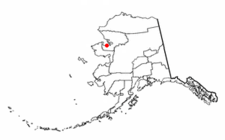Kotzebue Sound
Kotzebue Sound is an arm of the Chukchi Sea in the western region of the U.S. state of Alaska, located at 66°40′N 163°0′W / 66.667°N 163.000°W. It is on the north side of the Seward Peninsula and bounded the east by the Baldwin Peninsula. It is 100 miles (160 km) long and 70 miles (110 km) wide.

Kotzebue Sound is located in the transitional climate zone, which is characterized by long, cold winters and cool summers. The average low temperature during January is −12 °F (−24 °C); the average high during July is 58 °F (14 °C). Temperature extremes have been measured from −52 °F (−47 °C) to 85 °F (29 °C). Snowfall averages 40 inches (1,016 mm), with total precipitation of 9 inches (229 mm) per year. Kotzebue Sound is ice-free from early July until early October.
The towns of Kotzebue, Kiwalik and Deering are on the shores of Kotzebue Sound.
Kotzebue Sound was explored and named in 1816 by Baltic German Lt. Otto von Kotzebue while searching for the Northeast Passage in the service of Russia.
Further reading
- Giddings, J. Louis, and Douglas D. Anderson. Beach Ridge Archeology of Cape Krusenstern Eskimo and Pre-Eskimo Settlements Around Kotzebue Sound, Alaska. Washington DC: National Park Service, U.S. Dept. of the Interior, 1986.
- Lucier, Charles V., and James W. VanStone. Traditional Beluga Drives of the Iñupiat of Kotzebue Sound, Alaska. Fieldiana, new ser., no. 25. Chicago: Field Museum of Natural History, 1995.
